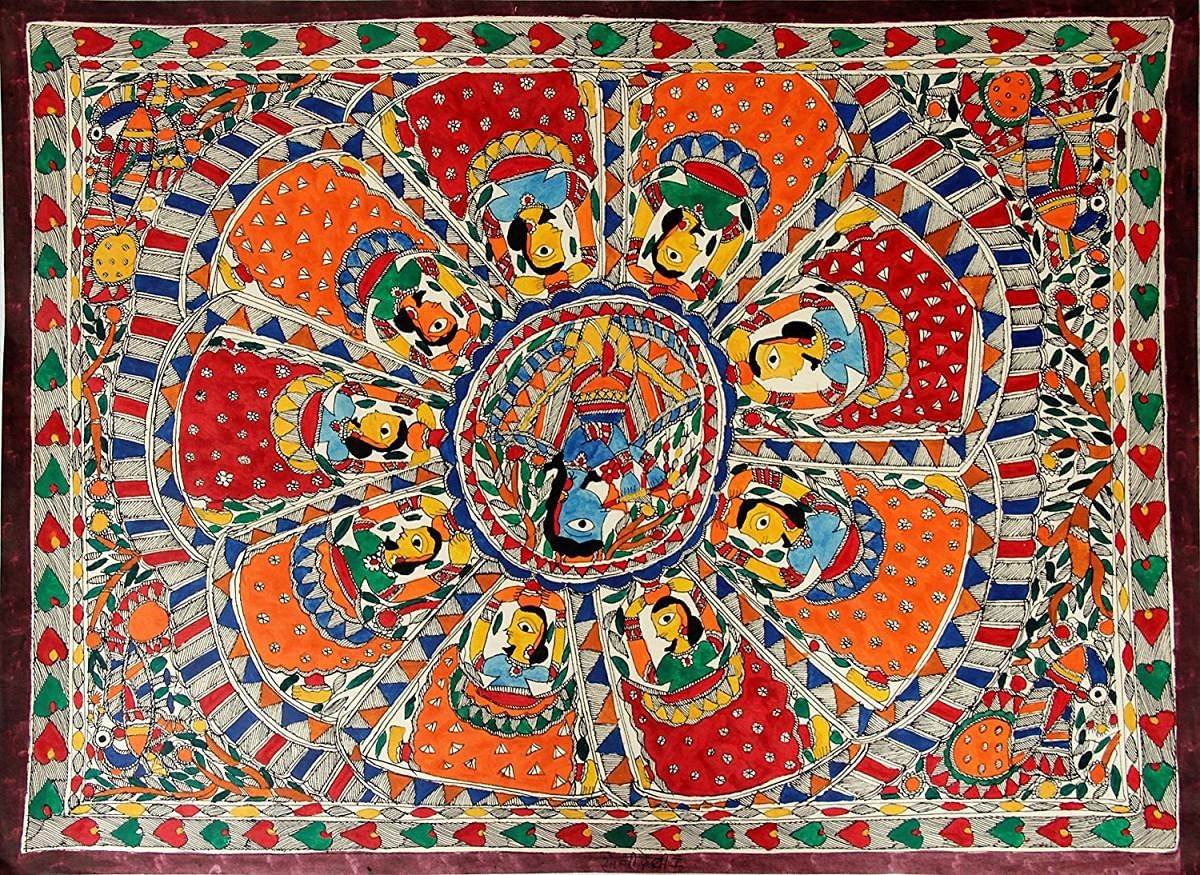
It was as early as 9 in the morning when I reached Ranti village. The sun was beating down mercilessly on the quaint hamlet, and children ran around on the narrow roads chasing one another. I was sweating hard, even as the warm wind whistled in my hair. However, my mission for the day was clear. I wanted to familiarise myself with the famous Madhubani paintings. The very same art form that is distinct to the Mithila region of Bihar, and is centuries old.
As I made my way to my guide Mahesh Jha’s house, I was mesmerised by the colourful artworks on the walls of mud houses and compounds. It was almost like walking in an art museum. Marvelling at both the figures and the colours in the artworks, I soon reached Mahesh’s house where I was greeted with a cup of chai and friendly smiles by his family of six. I was grateful for the warm welcome, and lost no time in asking them to introduce me to Madhubani art. Mahesh’s mother, an octogenarian, found my curiosity about the art form a bit amusing. She asked me, “What is there to know about it?” Not surprising, for, Madhubani paintings are a part of their lives, something that they have grown up with.
Symbolic
Yes, this art form was originally done in the Mithila region of Bihar to adorn the walls of mud houses. It was a creative expression of their lives, experiences and happenings and a folk art passed on from one generation to another, from a mother to her daughter. As Mahesh puts it, “It was originally done by the womenfolk to welcome deities into homes to bless the family, and to ward off evil spirits.”
Scanning the walls of Mahesh’s house closely, I found figures from nature, that of gods and goddesses from Hindu mythology, like Rama, Krishna, Shiva, Durga, Lakshmi and Saraswati, and of course, that of the Sun and the Moon. On the compound walls were stills from wedding ceremonies, royal courts, religious rituals, and cultural events such as festivals and gatherings. However, common among these paintings were geometric patterns to fill up blank spaces, as also bird and animal motifs, and symbols of fertility and prosperity like fish, parrot, elephant, turtle, bamboo tree, lotus, etc. According to Mahesh, the most popular figures from Hindu mythology in Madhubani paintings are Lord Ram and Sita, as Sita is believed to be born in this region of Mithila. “That is why the other name for this art form is Mithila paintings,” said Mahesh, adding, “Each symbol used by the Madhubani artists symbolises something. While fish signifies good luck, serpents are seen as protectors.” As I marvelled at the colourful paintings, Mahesh volunteered to take me through the making of the canvas. “Initially, walls and floors on which these paintings were to be done were first coated with cow dung and mud paste. On drying, they were painted with rice paste. Now, handmade paper coated with a layer of cow dung, is used” he said.
Steeped in tradition
Earlier, only rice paste for framework, and natural dyes and vegetable colours to fill the figures, were used. For instance, charcoal and soot for black, turmeric extract for yellow, red from sandalwood, blue from indigo and so on. The traditional method of making colours was to mix natural juices with resin from banana leaves and ordinary gum in order to make the paint stick to the painting medium. These naturally made paints were time-consuming to make. The solution was to switch to synthetic colours that are easily available in the market. These synthetic colours that come in powdered form are mixed with goat’s milk before use, I was told. However, to this day, black is generally obtained from lamp soot dissolved in gum. The most common colours used in these paintings are deep red, green, bright blue, black, light yellow and proud pink. The use of colours too has its own meaning. “Red and yellow stand for energy and passion, while blue signifies devotion, and green, fertility and prosperity,” added Mahesh.
Different shades
This is not all. The colours used are community specific, too, among the chief exponents of these paintings, the Brahmins and Kayasthas. Brahmins go in for bright shades, while Kayasthas prefer mute tones, I learnt. The most interesting part of these paintings is that the artists don’t trace out the design before filling it with colours. They flow naturally from the artist’s imagination. To help me understand the process, Mahesh’s wife used her fingers to draw a mythological figure, coloured it with a brush that was nothing but a small piece of cloth attached to a twig, and used a bamboo twig to draw out fine details like the features of the face, and dress. All within minutes. The dexterity with which she finished the painting made me wonder if the talent was inborn among the natives of Mithila.
The spellbinding art form would have remained within the region of Mithila if not for the drought in the 1960s that robbed the villagers of their agricultural income. Driven by poverty, they had to think of an alternative source of income. That is when the thought of making these paintings on handmade paper and offering it on sale struck them, and people from outside Mithila too got an opportunity to own and admire this art form. In effect, today, men are also actively engaged in creating Madhubani paintings for commercial purposes. And, the painting medium has also diversified. They are now being done on handcrafted paper, cloth, and canvas. It is heartening to note that they are actively being exported to different parts of the world, too. “In order to appeal to a wider audience, the patterns painted have also undergone a change. Secular motifs and modern designs have slowly replaced traditional ones, and found their pride of place on items as varied as greeting cards and scarves,” said Mahesh.